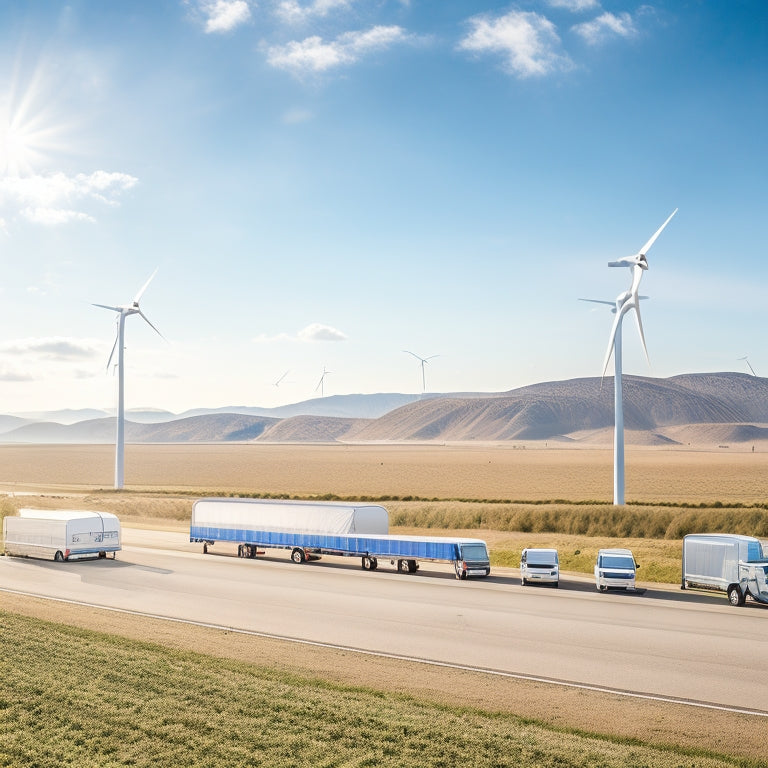
Power Your Fleet With Renewable Energy Solutions
Share
You can greatly reduce your fleet's carbon footprint and operating costs by shifting to renewable energy solutions, such as solar power, which offers a stable and clean alternative to fossil fuels. By harnessing solar energy, you can decrease your reliance on fossil fuels, lower emissions, and stabilize energy costs. With advancements in solar panel technology, energy storage solutions, and solar powered tracking, you can optimize energy harvesting and increase energy production. Explore the benefits of renewable energy solutions for your fleet and discover a more sustainable and cost-effective way to power your operations, opening up a future of reduced operating expenses and increased efficiency.
Key Takeaways
• Decarbonize your fleet by harnessing solar energy, reducing reliance on fossil fuels and lowering emissions.
• Invest in renewable energy infrastructure, such as on-site solar panels or wind turbines, to generate electricity for vehicles.
• Optimize fleet management strategies to maximize efficiency, reduce operating costs, and promote energy democracy.
• Benefit from cost savings through energy incentives, financial projections, and reduced exposure to market fluctuations.
• Shift to electric or hybrid vehicles, which require less maintenance, have lower fuel costs, and contribute to a more sustainable fleet management.
Harnessing Solar Energy for Fleets
As you explore ways to decarbonize your fleet, harnessing solar energy can be a vital solution, particularly for vehicles that operate in sunny regions or have fixed routes that allow for charging during the day.
One significant advantage of solar energy is that it can provide a stable source of power, reducing your reliance on fossil fuels and lowering emissions. To effectively integrate solar energy into your fleet, you'll need to take into account energy storage solutions, such as batteries, to guarantee a steady supply of power. This is especially important for vehicles that require continuous operation.
Moreover, achieving grid parity – where the cost of solar energy equals or surpasses traditional energy sources – is essential for making solar energy a financially viable option.
Benefits of Solar Powered Tracking
By integrating solar powered tracking into your fleet operations, you can optimize energy harvesting and reduce the complexity of your solar energy system. This technology allows your solar panels to dynamically adjust their angle and orientation to maximize energy output, guaranteeing you get the most out of your renewable energy investment.
With solar powered tracking, you can increase energy production by up to 45% compared to fixed-tilt systems, making your fleet more energy-efficient and cost-effective.
Additionally, solar powered tracking enhances grid resilience by providing a stable and reliable source of energy. This is particularly important for fleets that rely on energy-intensive operations, as it ensures uninterrupted power supply and reduces the risk of energy-related downtime.
Moreover, solar powered tracking promotes energy democracy by enabling you to take control of your energy needs, reducing reliance on the grid, and creating a more decentralized energy system. By adopting solar powered tracking, you can future-proof your fleet operations, reduce costs, and contribute to a more sustainable energy future.
Solar Panel Technology Advancements
Advances in solar panel technology have enabled the development of more efficient and durable photovoltaic cells, allowing you to harness more energy from the same amount of sunlight. This means you can generate more power from your fleet's solar panels, even in areas with limited sunlight. You'll benefit from higher energy yields, reduced maintenance, and a longer lifespan for your solar cells.
The latest solar panel technology also enables better energy storage. You can store excess energy generated during the day for use during periods of low sunlight or at night, ensuring a stable power supply for your fleet. This is particularly important for fleets operating in areas with variable sunlight patterns.
Furthermore, advancements in solar cell design have improved their durability and resistance to environmental stressors, such as extreme temperatures and humidity. This means you can deploy solar panels in a wider range of environments, confident that they'll perform reliably.
Fleet Management Made Efficient
As you shift your fleet to renewable energy solutions, you'll need to optimize your fleet management strategies to maximize efficiency.
You'll want to explore electric vehicle adoption, leveraging route optimization tools to reduce miles driven, and tracking fuel efficiency metrics to identify areas for improvement.
Electric Vehicle Adoption
With the increasing pressure to reduce greenhouse gas emissions and operating costs, you're likely contemplating electric vehicles (EVs) as a viable option for your fleet, and rightly so, as they offer a multitude of benefits. EVs can greatly reduce your fleet's carbon footprint, operating costs, and maintenance expenses.
Additionally, many governments offer vehicle incentives, such as tax credits or rebates, to encourage the adoption of EVs. These incentives can help offset the higher upfront cost of EVs, making them a more attractive option for your fleet.
When adopting EVs, it's crucial to examine the charging infrastructure required to support your fleet. You'll need to evaluate your fleet's charging needs, including the type and number of charging stations needed, as well as the electrical infrastructure required to support them.
Fortunately, many charging infrastructure providers offer tailored solutions that can meet your fleet's specific needs. By utilizing these solutions and taking advantage of vehicle incentives, you can successfully integrate EVs into your fleet and start realizing the benefits of electric vehicle adoption.
Route Optimization Tools
By leveraging route optimization tools, you can streamline your fleet operations, slashing fuel consumption, lowering emissions, and boosting productivity. These advanced software solutions enable you to plan and execute the most efficient routes, reducing miles driven and minimizing idling time.
With real-time analytics, you can monitor your fleet's performance and make data-driven decisions to optimize your operations. Dynamic routing capabilities allow you to adjust routes on the fly, responding to changes in traffic, weather, or other factors that might impact your fleet's efficiency.
Fuel Efficiency Metrics
You can greatly reduce your fleet's environmental footprint and operating costs by tracking and analyzing several key fuel efficiency metrics, including fuel economy, carbon emissions, and idling time. By monitoring these metrics, you can identify areas for improvement and optimize your fleet's performance.
Here are three key fuel efficiency metrics to focus on:
-
Fuel consumption: Monitoring fuel consumption helps you identify vehicles with poor fuel economy, allowing you to make adjustments to reduce fuel waste and lower operating costs.
-
Vehicle performance: Tracking vehicle performance metrics, such as engine performance and transmission efficiency, helps you identify opportunities to improve fuel efficiency and reduce emissions.
-
Idling time: Reducing idling time is essential for improving fuel efficiency and reducing emissions. By tracking idling time, you can implement strategies to minimize unnecessary idling and reduce fuel waste.
Cost Savings of Renewable Energy
Moreover, switching to renewable energy sources can greatly reduce your fleet's operating expenses, as it eliminates or decreases your reliance on fossil fuels, which are subject to volatile market prices. By doing so, you can stabilize your energy costs and reduce your exposure to market fluctuations. Moreover, renewable energy solutions can provide significant financial benefits through Energy Incentives and Financial Projections.
| Renewable Energy Solution | Cost Savings | Payback Period |
| Solar Panels | $0.05/kWh | 5-7 years |
| Wind Turbines | $0.04/kWh | 7-10 years |
| Biofuels | $0.02/gallon | 3-5 years |
| Geothermal Systems | $0.03/kWh | 5-8 years |
| Hydrogen Fuel Cells | $0.01/kWh | 8-12 years |
Future of Sustainable Fleet Operations
As you look to the future of sustainable fleet operations, you'll need to take into account the convergence of electric vehicle adoption, renewable energy infrastructure, and sustainable fleet management.
These interconnected elements will be essential in reducing your fleet's carbon footprint and operating costs.
Electric Vehicle Adoption
Fleets that prioritize electric vehicle adoption can greatly reduce their carbon footprint, with many organizations already witnessing a substantial decrease in greenhouse gas emissions and operating costs.
As you contemplate shifting your fleet to electric vehicles, you'll want to explore the various incentives available to support your efforts. These incentives can help offset the higher upfront costs associated with electric vehicles, making the shift more feasible.
Some key benefits to ponder include:
-
Vehicle Incentives: Governments offer rebates, tax credits, or exemptions to encourage the adoption of electric vehicles, which can help reduce your costs.
-
Charging Infrastructure: Investing in charging infrastructure can provide a convenient and efficient way to keep your vehicles powered up and on the road.
-
Reduced Operating Costs: Electric vehicles require less maintenance and have lower fuel costs compared to traditional internal combustion engines, resulting in significant long-term savings.
Renewable Energy Infrastructure
You'll likely need to invest in renewable energy infrastructure to support your electric vehicle fleet, particularly if you're aiming to power your vehicles with 100% renewable energy. This infrastructure includes on-site solar panels, wind turbines, or geothermal systems that generate electricity. Additionally, you may need to invest in energy storage systems, such as batteries, to guarantee a stable and reliable energy supply.
| Renewable Energy Source | Benefits | Challenges |
|---|---|---|
| Solar Panels | Zero emissions, low maintenance | Intermittent energy supply, high upfront costs |
| Wind Turbines | High energy output, scalable | Noise pollution, visual impact |
| Geothermal Systems | Consistent energy supply, low emissions | High upfront costs, limited scalability |
| Energy Storage Systems | Ensures grid resilience, stable energy supply | High upfront costs, limited capacity |
| Grid Connection | Access to grid resilience, backup power | Dependence on grid infrastructure, potential outages |
When designing your renewable energy infrastructure, it's crucial to take into account factors such as energy storage, grid resilience, and energy output to secure a reliable and sustainable energy supply for your electric vehicle fleet.
Sustainable Fleet Management
To guarantee smooth fleet operations, incorporating sustainable practices into daily fleet management is essential for reducing environmental impact and optimizing resource allocation. As you work towards creating a more eco-friendly fleet, you'll need to rethink your management strategy. This involves implementing green initiatives that not only benefit the environment but also your bottom line.
Some key areas to focus on include:
-
Optimizing routes and schedules: By streamlining your fleet's routes and schedules, you can reduce fuel consumption, lower emissions, and decrease your carbon footprint.
-
Electrifying your fleet: Shifting to electric or hybrid vehicles can notably lessen your fleet's environmental impact and operating costs.
-
Monitoring and analyzing performance data: Regularly tracking and analyzing your fleet's performance data can help you identify areas for improvement and make data-driven decisions to reduce waste and increase efficiency.
Frequently Asked Questions
Can I Use Renewable Energy for Both Heavy-Duty and Light-Duty Fleets?
You can electrify both heavy-duty and light-duty fleets, just like UPS did with its 1,000-vehicle fleet conversion. Fleet electrification involves vehicle conversions, enabling you to shift to renewable energy sources, ensuring a safer, more sustainable operation.
Are There Any Government Incentives for Adopting Renewable Energy Solutions?
You can leverage government incentives like Tax Credits and Grant Funding to offset renewable energy solution costs, while staying updated on Policy Updates to maximize Financial Benefits, ensuring a safe and cost-effective shift.
Can Solar Panels Be Installed on Existing Fleet Vehicles?
'As you rev up your eco-friendly journey, you're wondering if solar panels can ride shotgun on your existing fleet vehicles. Fortunately, yes, they can be installed, but it requires careful Vehicle Integration and precise Panel Sizing to guarantee a safe and efficient ride.'
How Does Renewable Energy Impact the Overall Fleet Maintenance Strategy?
As you integrate renewable energy into your fleet, you'll notice improved fuel efficiency and a reduced carbon footprint, allowing you to refine your maintenance strategy, ensuring safer, more environmentally friendly operations with optimized resource allocation.
Are There Any Cybersecurity Risks Associated With Solar-Powered Tracking Systems?
When installing solar-powered tracking systems, you must consider cybersecurity risks, including potential data breaches and network vulnerabilities, which can compromise your fleet's operational integrity and safety.
Related Posts
-

What Tax Deductions Apply to Sustainable Building Materials?
You can claim various tax deductions for sustainable building materials, thanks to over 40 federal tax incentives sup...
-

3 Sun-Powered Automated Shades for Energy-Savvy Homes
You're looking to change your home into an energy-savvy haven, and sun-powered automated shades are an essential step...
-

Smart Energy: Greener Homes With Connected Power Devices
You can control and optimize your energy consumption with smart energy devices, reducing your carbon footprint by up ...


